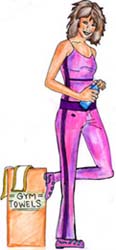 Ask your grandmother what core training is and she might think it has something to do with the correct way to prepare an apple. A buzzword of the 20th century, core training refers to strengthening and stabilizing the midsection of the body. A strong midsection is critical for any number of things, from posture and balance to preventing injuries from day to day activities like lifting your toddler or getting groceries out of the car to reaching that nearly out-of-reach can of beans in the pantry. Maintaining a strong core may also prevent ailments like lower back pain.
Ask your grandmother what core training is and she might think it has something to do with the correct way to prepare an apple. A buzzword of the 20th century, core training refers to strengthening and stabilizing the midsection of the body. A strong midsection is critical for any number of things, from posture and balance to preventing injuries from day to day activities like lifting your toddler or getting groceries out of the car to reaching that nearly out-of-reach can of beans in the pantry. Maintaining a strong core may also prevent ailments like lower back pain.
What is the core?
The core muscles are the muscles in your back, abdomen and hip region. These are the deep stabilizing muscles that attach to either the spine (to assist in posture and stability) or the pelvis (to assist movement). Some examples of these muscles are the internal and external obliques, the gluteus maximus and lattisimus dorsi (lats) to name a few.
Why is core strengthening important?
This area is the powerhouse of your body, providing muscular connection between your upper and lower body.
A strong core or midsection means:
- Increased stability of the spine and pelvis; better posture.
- Improved body control and balance.
- Efficient transfer of power from the spine and/or pelvis to different muscle groups, thereby making you less prone to injury.
Core strengthening exercises
The most efficient way to strengthen the core muscles is to train the body as a whole, instead of isolating muscle groups. This is called “functional training.” Just like the combinations of movements in your daily life (lifting heavy bags, while walking or running, or lunging to make that tennis shot), so too should core training be combined into your regular exercise regimen. This will keep workouts fresh, challenging and continually confusing to your body, which is critical in order to get the most out of each workout.
Some examples of combining core strengthening exercises with your regular workouts are:
- Sit on a balance ball while doing an upper body workout (this requires your core to be continually engaged, to keep your balance on the ball, while you concentrate on that perfect bicep curl).
- Stand on a wobble board (a flat piece of wood attached to a semi-circular block of wood, not unlike a seesaw, which requires you to find equilibrium) while doing tricep kick-backs.
- Hold a dumbbell of appropriate weight (you should be able to do 10-12 repetitions, but the 11th and 12th repetition should require significant effort) in either hand, with palms facing the side of your body.
- Bend from the waist and assume a skiing position (as if you were just about to sit in a chair), arms should be bent at the elbow so that the dumbbell is now closer to the waist and your elbows are pointing to the back of the room.?
- Keeping your upper arms glued to the side of your body, straighten your arms by bringing the forearms straight out behind you, all the while trying not to move your upper arms at all.
- Return your arms to the bent elbow position with the dumbbells near the waist.
- Plank/Bridge poses — works at strengthening the core as well as the shoulders/arms.
- Lie on your stomach on the floor, arms close to your body and legs just about six inches apart.
- Bring your arms under you as if you were going to prop yourself onto your elbows and at the same time turn your toes under.
- Raise yourself on your elbows and toes so that no other part of your body touches the floor and try and maintain a flat back.
- Contract your abdominal muscles (pull your belly button toward your spine).
- Maintain this position for 30 seconds at a time, bring yourself down to rest and return to plank pose at least 3 times.
- Your goal should be to be able to hold the pose for 90 seconds at a time with a 30 second rest in between repetitions.
- Lateral plank — Once you master the plank, challenge yourself further by doing it on either side, whereby you bring yourself up on one elbow and your body faces the front of the room instead of down.
- Yoga and Pilates providing a great cross platform of functional exercises for the core and other muscle groups.
Be creative! Almost any exercise that you do on the floor with free-weights probably has an application on a balance mechanism such as a stability ball, a wobble board, a medicine ball or a bosu trainer. Just be sure to have fun with it, knowing that you’re doing your physical body a great service; having a strong core is critical.
